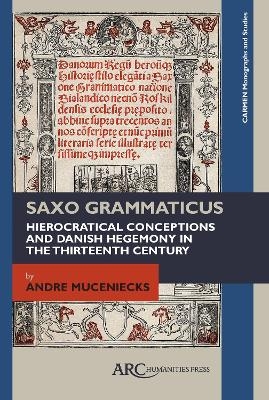
Saxo Grammaticus
Hierocratical Conceptions and Danish Hegemony in the Thirteenth Century
Seiten
2017
|
New edition
ARC Humanities Press (Verlag)
978-1-942401-13-1 (ISBN)
ARC Humanities Press (Verlag)
978-1-942401-13-1 (ISBN)
- Titel ist leider vergriffen;
keine Neuauflage - Artikel merken
Using the Gesta Danorum of Saxo Grammaticus as its main primary source, this works analyzes the transitions of the twelfth to thirteenth centuries in Denmark, particularly in the context of the Northern Crusades.
The twelfth to thirteenth centuries in Denmark were a time of transition, particularly in the context of the Northern Crusades. The Gesta Danorum of Saxo Grammaticus, a Danish cleric, was for several centuries an official and referential history in Denmark. Initially written under the commission of Archbishop Absolom, its sixteen books are traditionally divided into two parts, arbitrarily called "mythic" (books 1-9) and "historical" (books 10-16). The scheme of the Four Cardinal Virtues, first studied by Kurt Johanesson, provides referential and structural values, while what André Muceniecks terms the theme of the Counselor covers a principal narrative "kernel," inserted after the previously mentioned values as political conceptions and fundamental ideas. It is not sufficient for the king to be strong; he needs to be wise, and have a wiser man to guide him, here represented by the Archbishopric.
By interweaving this with the context, Muceniecks identifies a defense of hierocratic conceptions, even in books where Christianity is absent. The Gesta also defines a Danish hegemonic project in the Baltic, under guidance from the Archbishopric, grounded in the crusade movements. Such movements are presented through complex language and imagery about a glorious past brought to bear on the projects in the thirteenth century while internal tensions strengthen the monarchic and ecclesiastical institutions.
The twelfth to thirteenth centuries in Denmark were a time of transition, particularly in the context of the Northern Crusades. The Gesta Danorum of Saxo Grammaticus, a Danish cleric, was for several centuries an official and referential history in Denmark. Initially written under the commission of Archbishop Absolom, its sixteen books are traditionally divided into two parts, arbitrarily called "mythic" (books 1-9) and "historical" (books 10-16). The scheme of the Four Cardinal Virtues, first studied by Kurt Johanesson, provides referential and structural values, while what André Muceniecks terms the theme of the Counselor covers a principal narrative "kernel," inserted after the previously mentioned values as political conceptions and fundamental ideas. It is not sufficient for the king to be strong; he needs to be wise, and have a wiser man to guide him, here represented by the Archbishopric.
By interweaving this with the context, Muceniecks identifies a defense of hierocratic conceptions, even in books where Christianity is absent. The Gesta also defines a Danish hegemonic project in the Baltic, under guidance from the Archbishopric, grounded in the crusade movements. Such movements are presented through complex language and imagery about a glorious past brought to bear on the projects in the thirteenth century while internal tensions strengthen the monarchic and ecclesiastical institutions.
André Muceniecks is a Professor of Church History at the Baptist Faculty of São Paulo and a resarch fellow at the State University of Campinas.
1. Denmark and the Baltic in the Thirteenth Century
2. The Work
3. Political Conceptions
4. Euhemerism and the East in Saxo Grammaticus
5.Virtues and Values in Saxo Grammaticus: The Four Cardinal Virtues
6. The Thematic of the Counsellor
Conclusion
Appendix 1: List of the Kings in Books I-VIII of the Gesta Danorum
Appendix 2: Rulers and Archbishops of Denmark in Relation to Events in the Baltic, the Empire, and the Papacy
Appendix 3: Genealogy of the Valdemarian Kings
| Erscheinungsdatum | 28.03.2017 |
|---|---|
| Reihe/Serie | CARMEN Monographs and Studies |
| Zusatzinfo | 9 Tables, unspecified |
| Sprache | englisch |
| Maße | 156 x 234 mm |
| Gewicht | 624 g |
| Themenwelt | Geisteswissenschaften ► Geschichte ► Allgemeines / Lexika |
| Geschichte ► Allgemeine Geschichte ► Mittelalter | |
| Geisteswissenschaften ► Sprach- / Literaturwissenschaft ► Anglistik / Amerikanistik | |
| ISBN-10 | 1-942401-13-2 / 1942401132 |
| ISBN-13 | 978-1-942401-13-1 / 9781942401131 |
| Zustand | Neuware |
| Haben Sie eine Frage zum Produkt? |
Mehr entdecken
aus dem Bereich
aus dem Bereich
eine neue Geschichte des Mittelalters
Buch | Hardcover (2023)
C.H.Beck (Verlag)
CHF 53,20


